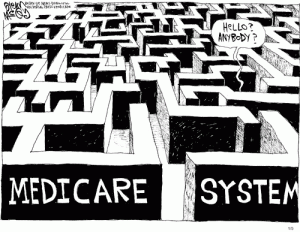By Jack Cumming
This is a long-form article about the potential for franchising to supplement or upend today’s senior living capital and branding concepts. The concepts may inspire new thinking about how we age in America.
In a recent Foresight article, the possibility of a nationally franchised senior housing brand came up. That led me to explore and consider the perils and possibilities of franchising senior living from bed and board through CCRCs. Franchising is not an entirely new idea, but no one, to the best of my knowledge, has ever run with the idea to build a trusted senior housing brand.
Not only might franchising build a trusted brand, but it is also an effective capital financing mechanism. Since many unbranded, unfranchised board and care facilities are already in place, the capital is already at work, but franchised branding can exponentially improve its market presence and value.
Branding Basics
A national brand can foster a loyal connection with customers (residents and their families in the case of senior living) and connote a consistently high-quality, trustworthy customer experience. Like trust in general, it can be challenging to deliver that consistency. Still, once trust or brand confidence is lost, it’s super difficult to regain. It takes a promoter’s genius to achieve brand dominance, which is key to success. It takes astute oversight to maintain it.
Senior housing in general lacks a dominant, trusted national brand. Ask most people what brand comes to mind when they think about senior housing, and you will draw a blank. Conversations with industry leaders indicate that most don’t think a national brand is even possible. The goal for a national senior housing brand would be to provide a safe choice when siblings decide that Dad needs a care home.
For those of us who are familiar with the industry, Brookdale might come to mind as a brand because of its prominence. Brookdale, though, has been shrinking, and it has not succeeded in highlighting quality as its branding characteristic. Investors may be focused on profit, but customers determine whether a brand grows or withers, and customers are looking for quality, reliability, integrity, and value.
This leads to the conclusion that the opportunity to create a truly trustworthy national brand for senior housing is still untapped.
Enter Franchising
To build an investor-dominated enterprise like Brookdale into such a brand would require considerable capital and a less venal vision for the board and executive leadership. On the other hand, small mom-and-pop board and care homes already exist, so any additional capital infusion needed can be much less. Franchising these homes to bring them recognition could be a path toward building a respected national brand.
Franchising offers the opportunity to boost unknown local providers to national prominence by enforcing high-quality standards and promoting that quality with a nationwide creative advertising and public relations campaign. The choice of name should not be too cute. For instance, Evercare Homes is a straightforward name that might work, although I could imagine Home Instead, which already has a minimal brand identity, stepping forward in its own name.
The best-known senior care brand, to my mind, is “A Place for Mom,” which is a referral service to facilities that need a sales boost. APFM has had a successful advertising program featuring Joan Lunden. Its reputation has been adversely affected by the appearance of a conflict of interest with its customers. Still, it was that very effective advertising campaign that gave it the momentum and dominance to gain primacy among referral agencies.
Beyond Restaurants
When we think of franchising, we primarily think of restaurant chains like McDonald’s. Bill Marriott took an A&W Root Beer stand in Washington, DC, developed it into the Hot Shoppes restaurant franchising chain, and then moved from that into a franchising model for hotels. Of course, his journey of discovery and growth was not as straightforward as that makes it sound.
Though restaurant chains are often franchised, the great Marriott hotel expansion was financed using Real Estate Limited Partnerships, which allowed investors to even out taxable earnings. Many of the tax benefits were removed by the Tax Reform Act of 1986, but by then, Marriott was a dominant hotel enterprise.
That brings us to what might be possible for senior living. The primary examples for franchising in eldercare are in the home care segment, which does not receive as much trade press commentary as do the more capital-intensive housing business models. The leading franchisor is Home Instead Senior Care with 1,200 franchises. Brookdale is sometimes mistakenly viewed as a franchise organization, and it might have thrived if it had gone in that direction with better leadership.
Board and Care Opportunity
The home care industry has been growing rapidly of late. The challenge is that, eventually for clients, home care is not enough. At that point, those who have succeeded in aging in their own home with a little assistance from a home care provider have to transition to a more intensive care situation.
Some assisted living communities do a good job, though many are institutional and corporate, lacking the warmth that families want for those they love. There are even some Type B and C CCRCs that are the costly stop of last resort as life trends toward its close. That brings us to small mom-and-pop care homes.
The statistics are not as reliable as we might wish, but the data sources highlighted in the next paragraph suggest that there are thousands of small board and care homes across the country, just as there are thousands of home care providers. There is nothing to help consumers decide which of these relatively anonymous entities is the one to trust.
Data from the National Center for Health Statistics (NCHS) indicate there were over 32,200 residential care communities in the U.S. in 2022, housing over 1 million residents. LeadingAge has just 5,400 member organizations, so you can do the math.
One Family’s Experience
Obviously, the quality of such small care homes varies widely from one to another. Recently, a friend detailed the challenge of finding a suitable home for a parent. Given the decline in the friend’s parent’s awareness, an attempt to use a standard corporate facility, failed quickly, and the facility’s entanglements (minimum notice, etc.) made it an experience that no one would wish.
After that negative experience, my friend and his wife struggled to keep their loved one at home, where he could be cherished instead of merely warehoused. Eventually, that just became impossible, and they looked for a local board and care that might be more loving. The first care home, while physically adequate and costing $7,500 per month, provided poor quality.
Staff were disengaged and unhelpful. For instance, the delivery of the loved one’s favorite chair was met with disdain. The deliverer asked directions to the resident’s room, and instead of helping, a caregiver dismissively just pointed. An attempt to find a television program consistent with a viewer’s interests was met by a staff member saying that they just go with “whatever’s on.”
Fortunately, unlike his experience with the larger corporate facility, my friend was able to move his parent to a different small home community that cost $11,500 per month. The difference was immediate and profound. The new staff was attentive, proactive, and focused on delighting both the resident and the family. As soon as they learned what the resident liked, they stocked his favorite drinks and ice cream (even a premium brand), and remembered my friend’s coffee preference, having it ready when he visited without being asked.
Family members and family visits can be the difference between a good reputation and a poor one. My wife and I moved to a CCRC early, primarily based on the good experience her parents had at Rivermead in Peterborough, NH. The same dynamics applies across the spectrum from the smallest communities to the largest.
Little things like Coke and/or Pepsi can make the care home experience top-notch beyond so-so. Franchising standards, consistently maintained and delivered, can not only give prominence to conforming franchisees but can also elevate the residential experience. It wouldn’t take that much effort to make such a trusted brand a nationwide reality. The bigger challenge would be the creative job of making the public aware of the arrival of a trusted brand for eldercare.
America Wants to Age at Home
Growing in popularity is the idea of staying put until necessity dictates otherwise. “Staying put” may mean “not moving,” or it may mean avoiding “retirement” or “care” homes. Moving to an attractive ownership apartment may seem less traumatic than moving into an old-age community. The notion of retirement is evolving rapidly with more and more older people still thinking of themselves as active and productive.
Imagine, for a moment, the possibility of a standby model in which people live in the larger community until the time comes when they can no longer manage their own affairs. At that point, precontracted assistance is curated by a care manager, responding to whatever is needed to sustain the person at home until that is no longer possible. Then, for their remaining time on earth, they transition seamlessly to a trusted nearby intimate board and care home.
Meeting these new sensibilities with a franchising model could be a natural evolution for home care like Home Instead or even for “A Place for Mom,” which became a recognized brand despite the drawbacks of its selective referral model. Click here for a fascinating interview with Pamela Temple, the cofounder of APFM. Imagine if it were about affiliation standards rather than just referral fees.
That idea for a nationally branded, franchised continuous care model may have been Gene Guarino’s entrepreneurial vision before COVID took his life. Gene Guarino founded the Residential Assisted Living Academy, which his daughter now carries forward. RAL’s purpose is to train those who want to start or improve a board and care home, teaching them how to succeed in the business. Of course, that kind of startup assistance and training is central to a franchised business. What’s missing is lifting that training concept to be a well-trusted, predictable, and recognized national brand.
There are so many ways in which the elements of aging at home, transitioning to intensive care, and promotion can be knit together that it would be presumptuous to try to flesh out those details here. That is the stuff of the entrepreneurial mind.
Brand Trust and Awareness
Success in branding and in franchising requires a creative campaign to achieve quick dominance. Slow growth does not work well with national branding. Steve Jobs worked with Lee Clow, a TBWA/Chiat/Day creative genius. Apple is today a household trusted brand. Jeff Bezos was lucky to have married Mackenzie Scott and to have hired Shel Kaphan as an early employee. They turned out to be highly skilled at garnering favorable media coverage, i.e., free publicity for Bezos’s book-selling idea. Creative promotion is critical to successful entrepreneurial disruption.
For now, if you mostly read senior living industry trade press, everything seems rosy with the current models and the looming demographic bulge. Yet, below the surface, there are restless clients and resistant prospects who are open to new thinking. That creates an opportunity. Franchising, if done right, can harvest that opportunity. Seth Sternberg, Jake Rothstein, are you listening? People are eager for new adventures in their lives after the children leave home.
Steve Monroe recently shared his sense of these latent concerns in a video at https://youtu.be/gvEoin-chJI. Steve cares deeply about the industry. He has been tested both in life and business. When Steve has a “feeling,” it usually forebodes something to heed. Could franchising be it? Sometimes a hunch is more valid than the best analyses.
Transition Opportunity
This leaves open the question of what will happen to the existing senior housing stock when the baby boomers are gone, or sooner, if there is a major shift in how America ages. Such a transformation can be very lucrative for the same businesses that now profit from developing and financing today’s business models.
Imagine the profit to be made for repurposing CCRCs as ownership residential communities for all ages, but with amenities on the premises, which might even include childcare. Converting to ownership allows selling a wholesale rental property at retail owner-occupied pricing. The future is bright for those with the vision and the ability to seize it.
Wade in below with your thoughts about the future direction for the industry.








